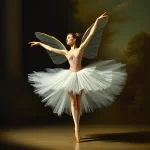Ballet: La Esmeralda (Cesare Pugni, 1844)

Introduction
Ballet: La Esmeralda is a captivating ballet that has enchanted audiences since its premiere in 1844. Choreographed by Jules Perrot and set to the music of Cesare Pugni, this ballet is based on Victor Hugo’s novel “The Hunchback of Notre-Dame.” The ballet premiered on March 9, 1844, at Her Majesty’s Theatre in London. The story revolves around the beautiful gypsy girl Esmeralda, her love for the poet Gringoire, and the tragic fate that befalls her due to the machinations of the sinister Archdeacon Frollo.
Historical Background
Creation and Development
La Esmeralda was created during a period of significant artistic and social change in Europe. The Romantic era, characterized by its emphasis on emotion, individualism, and the sublime, heavily influenced the arts, including ballet. The ballet was inspired by Victor Hugo’s 1831 novel “The Hunchback of Notre-Dame,” which itself was a product of the Romantic movement. The novel’s themes of love, fate, and social injustice resonated deeply with audiences of the time.
Jules Perrot, a renowned choreographer, collaborated with composer Cesare Pugni to bring this story to the stage. Perrot’s innovative choreography and Pugni’s evocative score combined to create a ballet that was both emotionally powerful and technically demanding. The collaboration also involved other key figures, such as the set designer and costume designer, who helped to create the visually stunning production that captivated audiences.
Premiere and Reception
La Esmeralda premiered on March 9, 1844, at Her Majesty’s Theatre in London. The initial reception was overwhelmingly positive, with critics and audiences alike praising the ballet for its dramatic storytelling, beautiful music, and innovative choreography. Notable early performances included those by Carlotta Grisi, who originated the role of Esmeralda, and Lucien Petipa, who played the role of Phoebus.
The ballet was revived several times in the years following its premiere, with each new production bringing fresh interpretations and innovations. These revivals helped to cement La Esmeralda’s place in the ballet repertoire and ensured its continued popularity with audiences around the world.
Synopsis of the Ballet
Act I Summary
The ballet opens with a bustling scene in the streets of Paris, where we are introduced to the beautiful gypsy girl Esmeralda. She captivates the crowd with her dancing and charms the poet Gringoire, who falls in love with her. However, the sinister Archdeacon Frollo also becomes infatuated with Esmeralda and plots to possess her. Meanwhile, Captain Phoebus, a handsome soldier, is also drawn to Esmeralda’s beauty.
Act II Summary
In the second act, Frollo’s obsession with Esmeralda leads him to commit a series of heinous acts. He frames Esmeralda for the attempted murder of Phoebus, who has been wounded in a confrontation. Esmeralda is arrested and sentenced to death. Gringoire, who has married Esmeralda to save her from execution, tries to help her escape, but his efforts are in vain.
Act III Summary
The final act sees Esmeralda imprisoned and awaiting her execution. Frollo offers to save her if she agrees to be with him, but she refuses. As she is led to the gallows, Quasimodo, the hunchbacked bell-ringer of Notre-Dame who loves Esmeralda, tries to rescue her. Despite his efforts, Esmeralda is executed, and Quasimodo, heartbroken, kills Frollo in a fit of rage. The ballet ends with Quasimodo mourning over Esmeralda’s lifeless body.
Finale
The conclusion of La Esmeralda is both tragic and poignant. The ballet’s themes of love, fate, and social injustice are brought to a powerful climax, leaving a lasting impression on the audience. The final scene, with Quasimodo mourning over Esmeralda’s body, serves as a poignant reminder of the destructive power of obsession and the enduring strength of true love.
Musical Composition
Composer’s Role
Cesare Pugni, an Italian composer known for his work in ballet, played a crucial role in the creation of La Esmeralda. His score for the ballet is both evocative and emotionally powerful, perfectly complementing Perrot’s choreography. Pugni’s music captures the drama and intensity of the story, with notable pieces such as Esmeralda’s solo dance and the dramatic finale.
Musical Themes and Motifs
The score of La Esmeralda features several recurring musical themes and motifs that enhance the narrative and emotional impact of the ballet. For example, Esmeralda’s theme is light and lyrical, reflecting her innocence and beauty, while Frollo’s theme is dark and menacing, underscoring his sinister intentions. These musical motifs help to create a rich and immersive experience for the audience.
Famous Recordings and Performances
Over the years, there have been several iconic recordings and performances of La Esmeralda’s music. Notable recordings include those by the Bolshoi Ballet Orchestra and the Royal Ballet Sinfonia, both of which capture the beauty and drama of Pugni’s score. These recordings have helped to keep the music of La Esmeralda alive and accessible to new generations of ballet enthusiasts.
Choreography and Dance
Choreographer’s Vision
Jules Perrot’s vision for La Esmeralda was to create a ballet that was both emotionally powerful and technically demanding. His choreography is characterized by its dramatic storytelling, intricate footwork, and expressive movements. Perrot’s innovative use of mime and dance to convey the story’s emotions and themes was groundbreaking at the time and has influenced many subsequent choreographers.
Signature Dance Numbers
La Esmeralda features several signature dance numbers that have become iconic in the world of ballet. One of the most famous is Esmeralda’s solo dance, which showcases her beauty and grace. Another notable scene is the Pas de Deux between Esmeralda and Phoebus, which is both romantic and technically challenging. These dance numbers are not only beautiful to watch but also serve to deepen the audience’s understanding of the characters and their relationships.
Notable Interpretations
Over the years, different productions of La Esmeralda have interpreted and adapted the choreography in various ways. Some productions have emphasized the ballet’s dramatic elements, while others have focused on its technical challenges. Notable interpretations include those by the Bolshoi Ballet and the Royal Ballet, both of which have brought their unique styles and perspectives to the ballet.
Characters and Roles
Main Characters
- Esmeralda: The beautiful and kind-hearted gypsy girl who captivates the hearts of many.
- Gringoire: A poet who falls in love with Esmeralda and marries her to save her from execution.
- Frollo: The sinister Archdeacon who becomes obsessed with Esmeralda and plots to possess her.
- Phoebus: A handsome soldier who is also drawn to Esmeralda’s beauty.
- Quasimodo: The hunchbacked bell-ringer of Notre-Dame who loves Esmeralda and tries to save her.
Supporting Characters
- Fleur-de-Lys: Phoebus’s fiancée, who becomes jealous of Esmeralda.
- Clopin: The leader of the gypsies and a father figure to Esmeralda.
- King Louis XI: The king of France, who plays a role in Esmeralda’s fate.
Famous Dancers
Several notable dancers have portrayed the roles in La Esmeralda over the years. Carlotta Grisi, who originated the role of Esmeralda, is perhaps the most famous. Other notable dancers include Natalia Osipova, who has brought her own unique interpretation to the role, and Vladimir Malakhov, who has portrayed both Phoebus and Quasimodo in different productions.
Cultural and Artistic Impact
Influence on Ballet and Dance
La Esmeralda has had a significant influence on the world of ballet and dance. Its innovative choreography and dramatic storytelling have inspired many subsequent ballets and choreographers. The ballet’s themes of love, fate, and social injustice have also resonated with audiences and artists alike, making it a timeless and enduring work.
Cultural Significance
Beyond its impact on ballet, La Esmeralda has also made its mark on popular culture. The ballet’s story and characters have been adapted into various forms of media, including film, theater, and literature. These adaptations have helped to keep the story of La Esmeralda alive and relevant to new generations of audiences.
Legacy and Revivals
La Esmeralda continues to be performed and celebrated today, with major revivals and reinterpretations keeping the ballet fresh and exciting. Notable revivals include those by the Bolshoi Ballet and the Royal Ballet, both of which have brought new life to the ballet with their unique interpretations. These revivals ensure that La Esmeralda remains a beloved and enduring work in the world of ballet.
Iconic Productions
Historic Productions
Some of the most famous historical productions of La Esmeralda include those by the original cast at Her Majesty’s Theatre in London and subsequent productions by the Paris Opera Ballet. These productions featured key figures such as Carlotta Grisi and Lucien Petipa, who helped to define the roles and set the standard for future performances.
Contemporary Productions
Recent productions of La Esmeralda have brought new interpretations and innovations to the ballet. The Bolshoi Ballet’s production, for example, has been praised for its dramatic intensity and technical brilliance. The Royal Ballet’s production has also been noted for its beautiful choreography and emotional depth. These contemporary productions continue to keep La Esmeralda relevant and exciting for modern audiences.
Production Design
The set, costume, and lighting design in various productions of La Esmeralda have played a crucial role in bringing the story to life. Historical productions often featured elaborate sets and costumes that reflected the period and setting of the story. Contemporary productions have also embraced innovative design elements, such as modern lighting techniques and minimalist sets, to create a fresh and engaging visual experience for the audience.
Critical Reception and Reviews
Initial Critical Response
At the time of its premiere, La Esmeralda received overwhelmingly positive reviews from critics. They praised the ballet for its dramatic storytelling, beautiful music, and innovative choreography. The performances of Carlotta Grisi and Lucien Petipa were also highly acclaimed, with critics noting their technical brilliance and emotional depth.
Modern Reviews
Contemporary critics and audiences continue to hold La Esmeralda in high regard. Modern reviews often highlight the ballet’s timeless themes and emotional power, as well as the technical challenges it presents to dancers. The ballet’s continued relevance and popularity are a testament to its enduring appeal and artistic significance.
Fun Facts and Trivia
Behind-the-Scenes Stories
One interesting behind-the-scenes story involves Carlotta Grisi, who originated the role of Esmeralda. It is said that she was so dedicated to her performance that she would practice her dances for hours each day, even when she was not rehearsing with the rest of the cast. Her hard work and dedication paid off, as her performance was widely praised by critics and audiences alike.
Notable Performers
In addition to Carlotta Grisi, several other famous dancers have been associated with La Esmeralda over the years. Natalia Osipova, for example, has brought her own unique interpretation to the role of Esmeralda, earning critical acclaim for her performances. Vladimir Malakhov has also been praised for his portrayals of both Phoebus and Quasimodo in different productions.
Trivia
- La Esmeralda is one of the few ballets based on a work by Victor Hugo, a prominent figure in the Romantic literary movement.
- The ballet’s score by Cesare Pugni is considered one of his finest works and has been praised for its emotional depth and complexity.
- La Esmeralda has been adapted into various forms of media, including film, theater, and literature, helping to keep the story alive for new generations of audiences.
Conclusion
Summary of the Ballet’s Importance
La Esmeralda is a significant work in the world of ballet, known for its dramatic storytelling, beautiful music, and innovative choreography. The ballet’s themes of love, fate, and social injustice continue to resonate with audiences, making it a timeless and enduring work. Its influence on subsequent ballets and choreographers is also a testament to its artistic significance.
Final Thoughts
La Esmeralda is a ballet that has captivated audiences for over a century and continues to be performed and celebrated today. Its powerful story, beautiful music, and innovative choreography make it a must-see for any ballet enthusiast. Whether you are a seasoned ballet aficionado or a newcomer to the art form, La Esmeralda is sure to leave a lasting impression.
FAQ
What is the central theme of this ballet?
The central theme of La Esmeralda is the destructive power of obsession and the enduring strength of true love. The ballet explores themes of love, fate, and social injustice through its dramatic storytelling and emotional depth.
Who are the main characters in this ballet?
The main characters in La Esmeralda are Esmeralda, Gringoire, Frollo, Phoebus, and Quasimodo. Each character plays a crucial role in the story and contributes to the ballet’s emotional impact.
What is the most famous dance number in this ballet?
One of the most famous dance numbers in La Esmeralda is Esmeralda’s solo dance, which showcases her beauty and grace. Another notable scene is the Pas de Deux between Esmeralda and Phoebus, which is both romantic and technically challenging.
How long does a typical performance of this ballet last?
A typical performance of La Esmeralda lasts approximately two hours, including intermissions. The ballet is usually performed in three acts, with each act contributing to the overall narrative and emotional impact of the story.
Are there any modern adaptations of this ballet?
Yes, there have been several modern adaptations of La Esmeralda, including contemporary productions by the Bolshoi Ballet and the Royal Ballet. These adaptations bring new interpretations and innovations to the ballet while staying true to its original themes and story.
Why is this ballet considered important in the history of dance?
La Esmeralda is considered important in the history of dance due to its innovative choreography, beautiful music, and dramatic storytelling. The ballet has had a significant influence on subsequent ballets and choreographers, and its themes of love, fate, and social injustice continue to resonate with audiences today.





